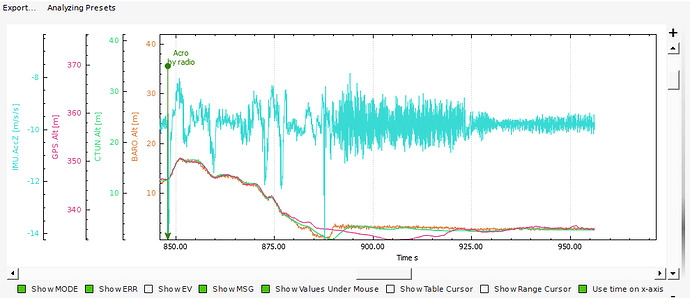Removed the parameter H_LAND_COL_MIN and functionality now uses H_COL_MID
Many users are unfamiliar with the H_LAND_COL_MIN parameter and in most cases leave it zero. So it was decided that I better setting would be the collective angle that produces zero thrust which is given by the H_COL_MID parameter. Now H_COL_MID not only is used for the collective to yaw feedforward feature (set by H_COLYAW) but also is used for the minimum collective the autopilot can command when not in dynamic flight (speed less than 5 m/s). This keeps the autopilot from setting the collective too low when on the ground.
If you do not have H_COL_MID set per the guidance above then you need to do so before flying AC 4.0.0rc1!!
Incorporated a rotor speed governor
This was a big step forward for the rotor speed controller. It now has it’s own rotor speed governor. No need to use external rotor governors, you can now use one that is built into the code. It requires that you outfit your helicopter with an RPM sensor and it does require the throttle curve to be setup properly. Here is the discuss thread that describes the setup of the governor.
Converted throttle curve parameters to %
Converted RSC_CRITICAL, RSC_IDLE, and RSC_SETPOINT to %
In an effort to make the set up of the rotor speed control more intuitive, the throttle curve parameters were changed to percent. Also the RSC_CRITICAL, RSC_IDLE and RSC_SETPOINT were changed to percent. In addition, the descriptions for each of the parameters were improved to aid in setting the parameter properly. All of these parameters are automatically converted to percent when you upgrade to AC 4.0.0
created swashplate library that has presaved swashplate types for use with Heli_Single and Heli_Dual
This was also a pretty significant improvement for tradheli. By creating a swashplate library, all of the presaved swashplate types can be used for any vehicle and for the Heli_Dual frames, the swashplate types can be set differently if desired. This also offers a 4 servo swashplate and to help with binding issues that are common with 4 servo swashplates, a linear servo feature was developed. The linear servo feature just linearizes the servo throw, thus eliminating coupling that can occur due to the servos being at different points in the servo arm arc.
The description of the setup for 4 servo swashplates and the linear servo can be found here. Soon there will be a wiki describing swashplate setup.
motor interlock with passthrough settable through RC option
In previous versions, the motor interlock has been tied to the input of RC channel 8. In AC 4.0.0, the motor interlock can be set to any RC channel using the RC channel function. If the passthrough mode is set then the input for the passthrough will be read from the channel assigned to the motor interlock. When upgrading, the motor interlock is automatically configured for RC channel 8
Removed collective too high pre-arm check
This is self explanatory but was done due to users flying acro.
Added virtual flybar for Acro flight mode
The trainer feature was modified that if you had non zero ACRO_PIT_BAL and ACRO_RLL_BAL then attitude would be leaked back to the current attitude. The two parameters dictate how quickly the requested attitude leaks back to the current alttiude. Here is a link to the discuss thread that describes this feature
Fixed H_SV_MAN minimum and maximum settings for Heli_Dual
Due to the mixing of the Heli_Dual, the minimum and maximum settings when using the H_SV_MAN feature didn’t work properly. These settings now drive both swashplates to full down and full up
